Contact
Assistant Professor of Apiculture & Urban Entomology
Phone: 501-671-2222
Fax: 501-671-2252
Email: jzawislak@uada.edu
Web: uaex.uada.edu/bees
University of Arkansas System
Division of Agriculture
Cooperative Extension Service
2601 N. Young Ave.
Fayetteville, AR 72704
About Honey Bees - Types, Races, and Anatomy
The Three Bees - Types of honey bees in a hive
There are different types of bees in a honey bee hive: Worker, Drone and Queen. Each has its own important roles and performs specific duties in a bee colony.
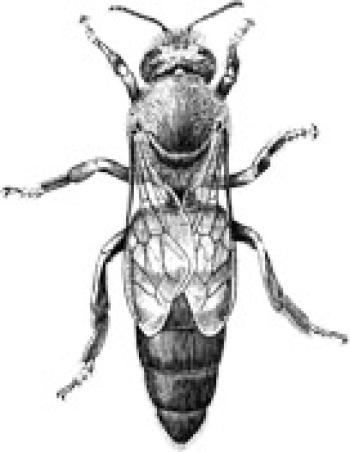 |
What is the queen bee?She can be recognized by her abdomen, which is usually smooth and elongated, extending well beyond her folded wings. What is the queen bee's role?Her function in the hive is one of production. She is normally the only reproductive female in the colony. Egg-laying begins in early spring, initiated when the first fresh pollen is brought home by the workers. Egg production will continue until fall, or as long as pollen is available. At the height of her productivity, the queen could lay as many as 2000 eggs each day. A queen bee can live for up to five years, but her period of usefulness rarely exceeds two or three years. Younger queens produce many more eggs, and older ones may produce excessive drones. Many beekeepers re-queen their colonies every year or two. Older queens are often superseded (replaced) by the workers without any assistance, or even knowledge, of the beekeeper. Good quality queens can be reared by an experienced beekeeper, but a beginner will usually do better to buy good queens from a reputable producer. What is the queen substance?Queen bees also produce a pheromone known as queen substance. This mixture of chemicals is passed individually from bee to bee throughout the entire hive as they share food. If a queen bee is removed from a colony, the workers will notice her absence within several hours because of the drop in the level of this pheromone. This queenless state quickly initiates the urge to rear a new "emergency" queen from the youngest available larvae (1-3 days old). The presence of this pheromone also inhibits the development of the workers' ovaries. After a period of queenlessness, some may become laying workers. Workers also evaluate their queen based on the quantity of the pheromones she produces. If workers begin to receive an insufficient dose each day, they may perceive her as poor quality, and begin making preparations to supersede her. Beekeepers often mark the queen's thorax with a dot of paint to make her easy to find, and to determine if she has been replaced. |
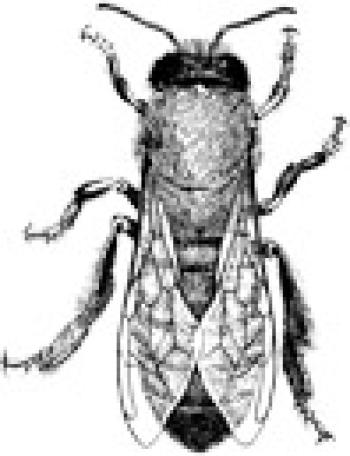 |
What are worker bees?Workers are the smallest of the bee castes, but are by far the most numerous. All workers are female, and normally incapable of reproduction. They are unable to mate, but in a hopelessly queenless colony, workers may begin to lay unfertilized eggs, which develop into drones. Workers do all of the necessary tasks within a colony including:
Workers have well-developed compound eyes on the sides of their heads, and three simple eyes (ocelli) at the vertex. Their tongue is well developed and elongated for taking up nectar from flowers. Worker bee lifespanWorkers reared in the spring and early summer tend to live for five to six weeks. The first two weeks of their lives is spent as house bees, doing tasks in the hive. The remainder of their time is spent as field bees, foraging for food outside the hive. Workers that reach maturity in the late fall may live well into the following spring. They must maintain a cluster of bodies around the queen bee, keeping her warm through the winter months. Later, when egg-laying resumes, they must raise the first generation of young bees the next year. |
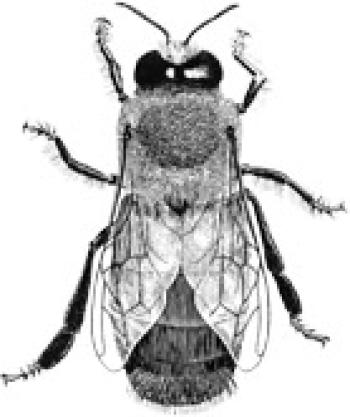 |
What are drones?Drones are the male honey bees. The only function of a drone is to fertilize a young queen bee.
|
What are the Races of Honey Bees?Around 20,000 species of bees have been described in the superfamily Apoidea. These all share a number of common traits that are unique to bees, and separate them from the rest of the Hymenoptera. While ants and wasps are carnivorous in at least some stage of their life cycle, bees are completely herbivorous, deriving all of their nutrition from the pollen and nectar of flowers (an exception to this is when, under nutritional stress, worker bees may kill and consume bee larvae, thus conserving the protein). The anatomy of the bee is superbly adapted for the collection of their food from flowers. Multiple species of bees are kept around the world.In some tropical regions of Africa, Australia, and the Americas, native stingless bees are kept for honey production. In Asia several species of Apis are utilized by people. But the western honey Bee, Apis mellifera, is the most common bee kept for honey and pollination around the world. Originating in Africa, the western honey bee spread across the entire continent and into Europe and the Middle East, occupying environmental niches. Over centuries in isolation, distinct races, or sub-species, of Apis mellifera adapted to specific regions and climates, and acquired recognizable differences in behavior, appearance, and disposition. Numerous races of the honey bee are recognized, and have been kept by people in many cultures throughout history.Each of the races of has genetic traits that are potentially desirable for beekeeping, such as honey production or disease resistance, and they may possess other traits that are less desirable, such as susceptibility to disease, or a highly defensive temperament. All of these races of honey bee are sub-types of a single species, and are capable of successfully interbreeding, resulting in hybrid bees types. |
 |
|
History of honey bee productionWhile honey hunting for wild bees' nests was probably common throughout the ancient world, the Egyptians were among the first to attempt keeping bees in artificial hives. Barges loaded with colonies of Apis mellifera lamarkii would travel up and down the Nile River, following the seasonal abundance of flora. As beekeeping methods spread, most ancient cultures are known to have kept the bees that were endemic to their regions. As Europeans explored and colonized other parts of the globe, they have transported and established the western honey bee on every continent except Antarctica. When did honey bees arrive in the U.S.?These bees adapted and thrived in many places while in others, they succumbed to parasites and diseases originally adapted to other bee host species. In the early 1600s, English colonists brought hives of Apis mellifera mellifera to the Jamestown settlement. These bees thrived in the old growth forests of the New World, and spread west in advance of the pioneers. These bees were said to be easily excitable, "runny" on the combs, and susceptible to some diseases, however they overwintered well in cold climates. In the mid-19th century, the Italian race of bees, Apis mellifera lingustica, was imported to the U.S. and became the most popular race of domestic honey bee due to a gentle disposition and high honey production. Africanized honey beesBees adapted to conditions in Europe faced fewer predators than those in Africa. The cold winters of northern Europe encouraged bees to gather excess honey for winter food, and forced the bees to develop their overwintering strategy of clustering for warmth. These traits helped the honey bees to thrive in North America, but when they were imported to South America, they did not fare as well in the tropical environment. In an attempt to breed a productive honey bee that was adapted to a tropical climate, Brazilian scientists in 1956 imported colonies of Apis mellifera scutellata from Tanzania. In 1957, some of the bees escaped and bred with populations of European honey bees in Brazil. These hybrids became known as Africanized honey bees (AHB) and thrived in the tropical environment. They quickly spread and have since moved through Central America and Mexico, effectively replacing most of the European bee stock in these regions. In 1990 the first AHBs were detected in Texas. In 2005 they had entered Arkansas. Re-queening colonies with bees of known gentle European stock will be essential in maintaining beekeeping in Arkansas with the arrival of the AHB.
|
||
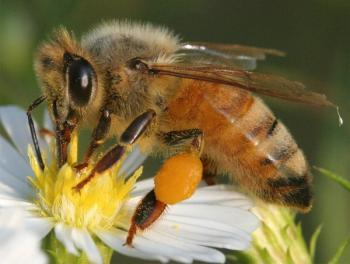
Anatomy of a Worker Honey Bee
The honey bee is an elegant creature, and a blend of aesthetics and functionality. Nearly every aspect of a honey bee's body and many of its behaviors are perfectly adapted for its role as a pollinator. (Photo by Jon Sullivan, pdphoto.org)
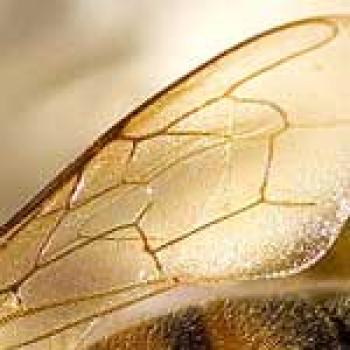
Wings of a worker honey bee
The ability to fly far and fast has greatly contributed to the success of bees. They can forage up to three miles from their hives, and reach speeds of 15 miles per hour. Bees have four wings, but a row of small hooks, called hamuli, on the leading edge of the hindwing fits securely into a groove on the trailing edge of the forewing, allowing the bee to couple the wings together into a single flight surface. When at rest, the bee can unhook its wings and fold them back. (Photo by Jon Sullivan, pdphoto.org)
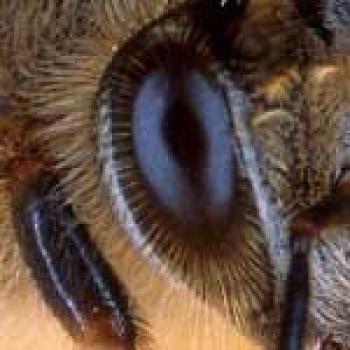
Compound eyes of a honey bee
Each of a honey bee's compound eyes contain over 6500 separate facets, allowing it to see in front, to the side, above and below itself. In addition, bees can perceive all the colors visible to humans except for red, which appears black to them. Honey bees, like many other insects, can see UV light as a separate color, which we cannot. Bees can also detect the polarization of UV light, which aids their navigation on cloudy days, when the sun is not visible in the sky. Bees also have three simple eyes, called ocelli, that are grouped together near the top of the head. These are sensitive to light, but cannot focus an image, and are likely used to orient to light. (Photo by Scott Bauer, USDA)
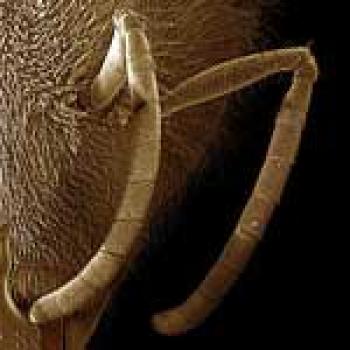
Antennae of a worker bee
A bee's antennae are covered with thousands of sensory cells for touch and smell. A bee's sense of smell is much more acute than any mammal's and is very important locating food and in communication between hive members. These sensitive organs also relay information about air speed and orientation during flight.
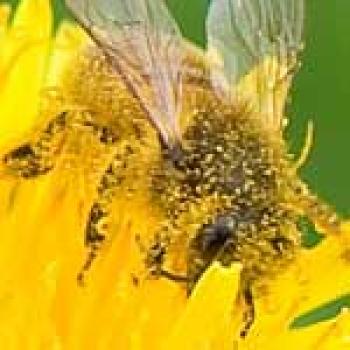
Branched setae
The bee's body is covered with branched setae, or feathery hairs. Pollen grains stick to these hairs as the bees forage on flowers. Some of the pollen is transferred to new plants, resulting in fertilization of the flowers. The rest is later combed into the pollen basket, and carried back to the hive. Most insects have some setae on their bodies, which aid in their sense of touch, but these finely branched hairs are unique to the bees. (Photo by Petr Kratochvil, www.publicdomainpictures.net)
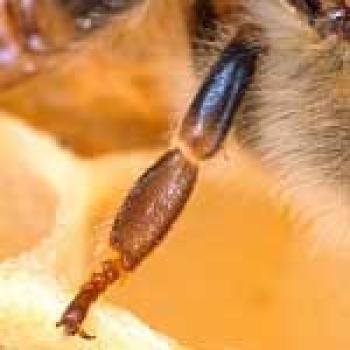
Legs of a worker bee
The bee's six strong legs provide a very stable base for walking or standing, ensuring
that at least three feet can contact the surface at all times when moving. Each foot
is equipped with claws for grabbing uneven surfaces, as well as a sticky pad for gripping
smooth surfaces. Each pair of legs is also equipped with special structures and arrangements
of setae for grooming the body or pollen and debris.
(Photo by Scott Bauer, USDA).
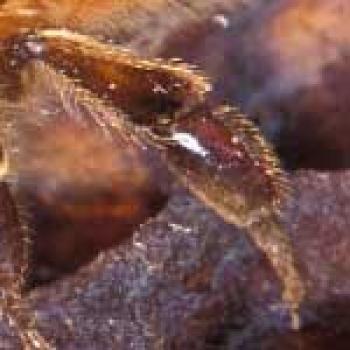
Pollen basket
The pollen basket, or corbicula, is made of long stiff hairs that curve around a wide flattened section of the honey bee's back leg. Stiff hairs on the other legs are used to comb pollen grains from the bee's body, which is compacted and stored in the pollen basket for transport back to the hive. (Photo by Scott Bauer, bugwood.org)
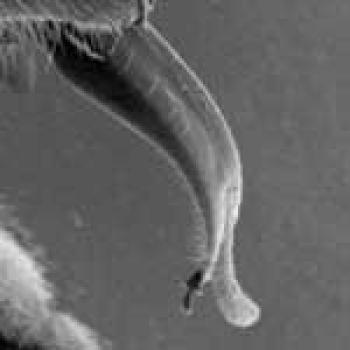
Proboscis
The honey bee has a long tongue, or proboscis, which it uses to lap up nectar from deep inside of flowers. (Photo by Rose-Lynn Fisher)
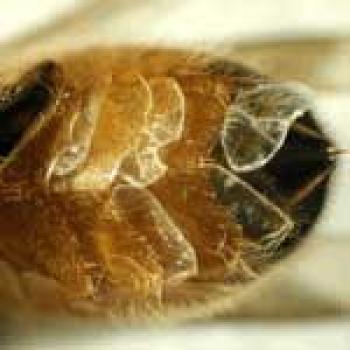
Wax glands
Wax glands on the underside of the bee's abdomen secrete flakes of beeswax, which is used to build the honeycombs. Many bees work together to produce and form the wax that becomes their home. Bees must consume at least eight pounds of honey in order to metabolize one pound of wax. (Photo by Zack Huang, cyberbees.net)
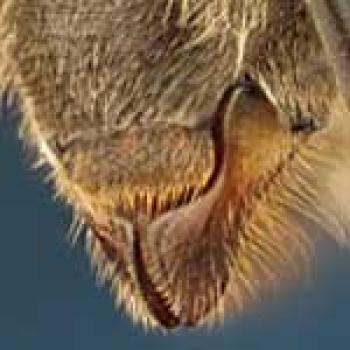
Honey bee mandibles
These mouthparts, or mandibles, are strong and very useful. The jaws are attached to powerful muscles, and can be used to pick up and remove debris from the hive, to attack intruders, and to delicately manipulate the wax into perfectly formed honeycombs. (photo by Charles Krebs)
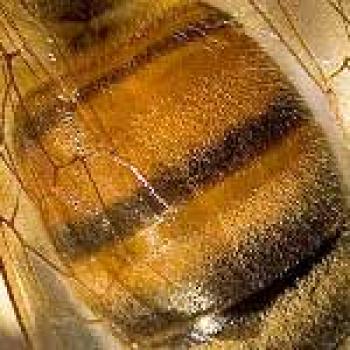
Warning colors
Yellow and black stripes are nature's warning colors. Like many wasps and bees, these highly visible markings warn other animals that the insect can be dangerous. Many harmless flies have adopted these colors as well, to fool predators into thinking they may be able to sting. (Photo by Jon Sullivan, pdphoto.org).
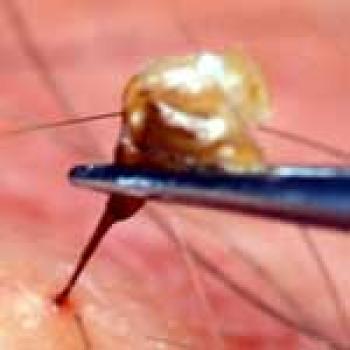
Honey bee stinger
The stinger is used by the bee only for defense. The end is barbed, like a fish hook, so it can penetrate skin, but not easily come out. When a bee stings, its stinger and attached venom sac is torn from her abdomen, and she will die shortly afterward. Honey bees are not naturally aggressive, and are reluctant to sting unless they feel that they, or their nest, are threatened. The shaft of the stinger is a modified ovipositor (egg-laying structure), and is therefore only found in worker bees. The queen bee's ovipositor is not barbed, and is used for egg-laying, but she can sting rival queens and occasionally will sting a careless beekeeper if she is mishandled. (Photo by Scott Bauer, USDA)
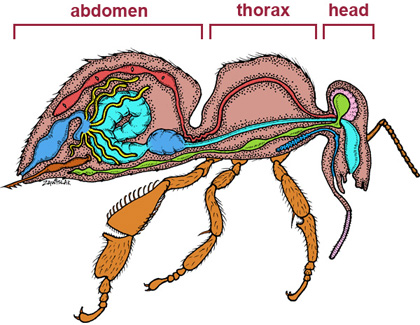
Internal Anatomy of a Honey BeeLike all insects, a honey bee's body is divided into 3 segments: the head, thorax, and abdomen (illustration by Jon Zawislak). |
|
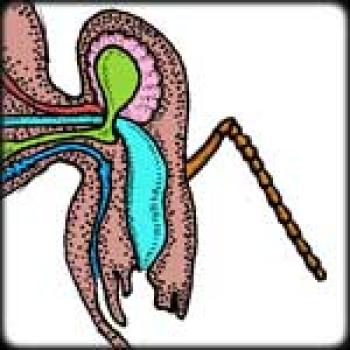 |
The head is dominated by large compound eyes, sensitive antennae and a complex arrangement of mouthparts. The bee's head also houses the brain and contains several important glands. |
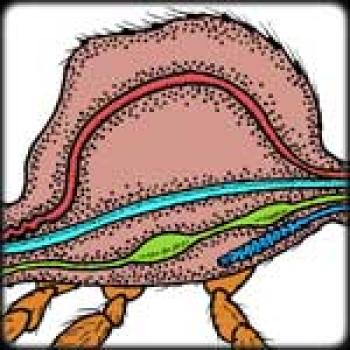 |
The thorax is primarily used in locomotion, as the attachment site for six legs and four wings. The ventral nerve cord, heart and esophagus pass through, but most of the space inside the thorax is taken up by sets of powerful flight muscles. Salivary glands are located ventrally, near the front of the thorax, connecting by a duct to the oral cavity in the head. |
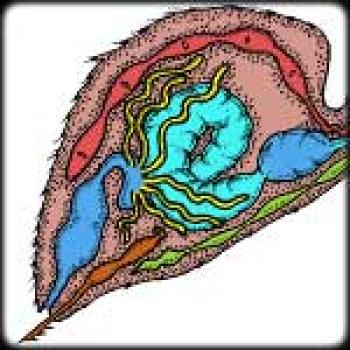 |
The abdomen protects the organs for the digestive system. Also present are the heart, venom sac, and several glands. The reproductive organs are also located in the abdomen. In a laying queen bee, the ovaries take up much of the space here, and account for the larger size of the abdomen. Among the sterile worker caste, however, these remain undeveloped. |
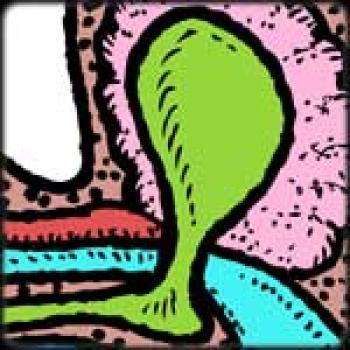 |
The brain appears dominated by the optic lobes, which process the visual input from the large compound eyes. Honey bees also have excellent memory processing and learning abilities, necessary for long foraging flights away from their hives. The brain coordinates and regulates the functions of all the bodily systems. While only about 1 cubic millimeter in size, the honey bee's brain contains some of the most densely-packed neuropil tissue known in any animal brain. |
 |
The ventral nerve cord runs the length of the bee's body, connecting the brain with all the other organs and systems. Numerous ganglia along the way assist in coordinating local neural processing. |
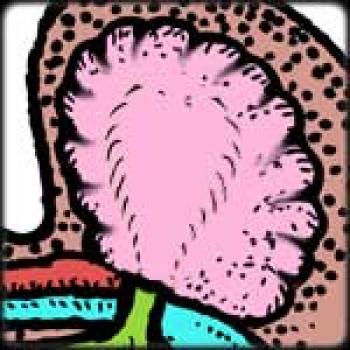 |
Worker bees possess a hypopharyngeal gland that produces royal jelly, or bee milk. This rich blend of proteins and vitamins is fed to all bee larvae for the first three days of their lives, after which workers and drones are fed a mixture of pollen and honey. When a female larva is fed continuously on royal jelly, she will rapidly develop into a queen bee. This nutritious diet will remain the only food that a queen will ever consume, allowing her to maintain a high level of continuous egg production. |
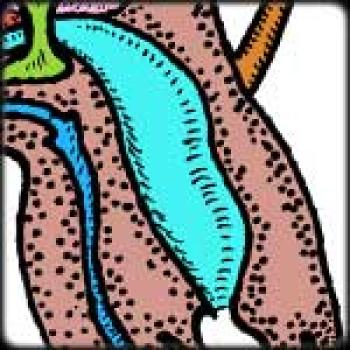 |
The pharynx is the first section of the alimentary canal. Strong muscles here provide suction to draw in nectar from flowers. This is also the site for taste reception in insects. |
 |
The honey crop (also called the honey stomach) is where the worker bee stores collected nectar for the trip back to the hive without digesting it. A muscular valve called the proventriculus can be closed, keeping the nectar from passing into the stomach. The crop is expandable, allowing the bee to carry a larger load. Back in the hive, the contents of the crop can be ejected back through the mouth for storage in a honey cell or to feed other bees by trophallaxis. |
 |
The true stomach (or ventriculus) is the site of primary digestion for pollen and nectar. Coiled around in the abdomen, it is actually about twice the length of the bee's body. The epithelial cells that line the stomach wall are the site of attack by the microsporidia Nosema. |
 |
The hind gut is composed of the intestine and rectum, where reusable metabolic products are reclaimed and excess water is reabsorbed into the body. The rectum is also distensible, and can hold a large volume of waste matter. Bees keep meticulously clean nests, and will hold their wastes until they can make a "cleansing flight" outside of the hive. In climates with long, cold winters, bees can actually wait for weeks or months to perform this task. |
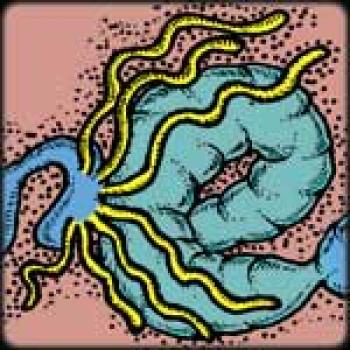 |
Numerous Malpighian tubules connect to the basal end of the hid gut and float freely in the abdominal cavity. They function much like the kidneys of vertebrates, removing excess salts and metabolic wastes from the blood and concentrating it into the intestine, where it can be removed. |
 |
Salivary glands are located in the front of the thorax, and connected to the mouth by a duct. This gland produces enzymes which aid in the breakdown of food. In particular, an enzyme called invertase is released, which functions to break down the sugars in nectar, and is essential to the process of converting it into honey. |
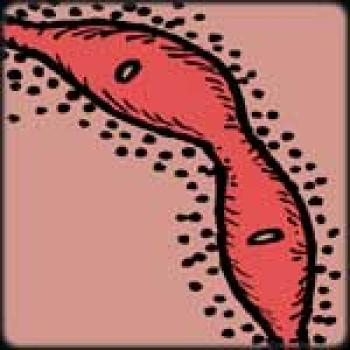 |
An insect's heart is simply a series of musculated chambers connected the aorta, a tube that runs forward to the head. When relaxed, blood from the abdominal cavity enters the heart chambers through openings called ostioles. When it contracts, the ostioles close, and blood is forced forward through the aorta to the brain, and then circulates back through the thorax, bathing all the organs and muscle tissues along the way. This type of open circulatory system is well well-suited for a small insect. |
 |
Connected to the stinger is a venom sac, which holds a mixture of protein chemicals (the venom) and alarm chemicals. These proteins can quickly cause a painful localized reaction in vertebrates, which can be severe to life-threatening in highly sensitive individuals. When a bee stings, the barbed shaft of the stinger is left behind, along with the venom sac. An attached muscle continues to pump venom through the stinger, even after it has been disconnected from the bee. For this reason, a bee stinger should be removed immediately by scraping it with a credit card or pocket knife blade, and not by pinching it, which can forcibly inject the venom into the skin. |
 |
The antennae are important sensory organs for the bee, which must remain clean in order to function effectively. Each of bee's front legs is equipped with an antenna cleaner. This specialized notch is lined with numerous fine, stiff setae. As the shaft of the antenna is drawn through, debris is removed. The tibial spur on the front legs helps to hold the antenna against the notch. |
 |
The tibial spur of the middle legs can be used to stab the fresh wax flakes secreted by glands on the lower abdomen. The wax can then be transferred to the mandibles where it is be shaped and positioned on the comb. |
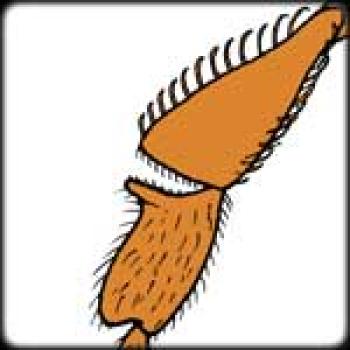 |
The pollen press is located just below the pollen basket on the hind legs. As pollen is combed from the rest of its body, the bee uses this leg joint to compress the grains into a dense mass, which can be more efficiently stored in the corbicula.
|
|
For further reading, The Anatomy Of The Honey Bee by R.E. Snodgrass is now available online in the Google Book archive. For detailed video lessons on honey bee structure visit the Understanding Bee Anatomy website. |
|